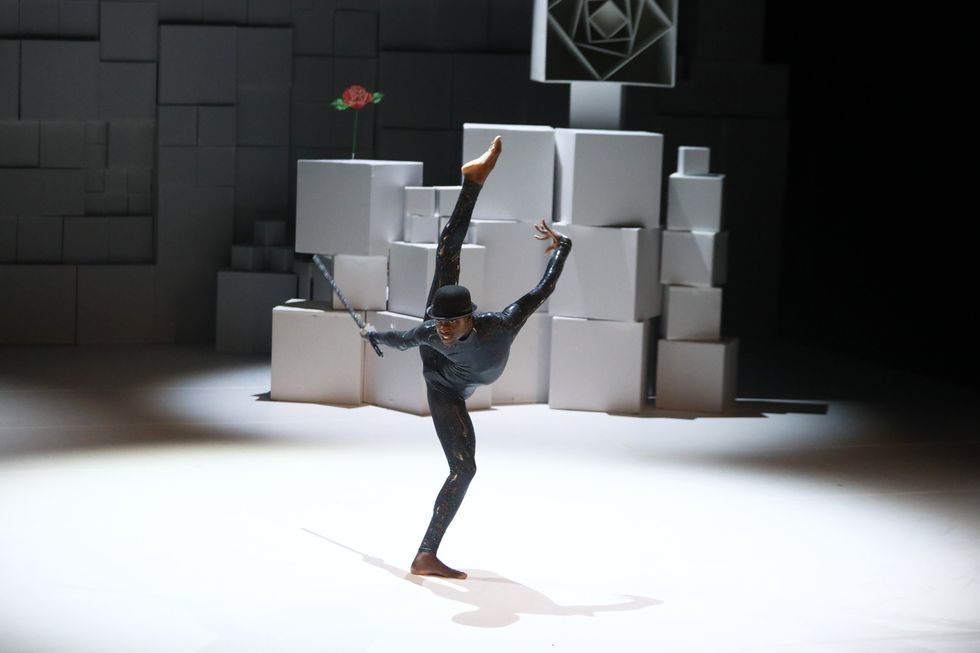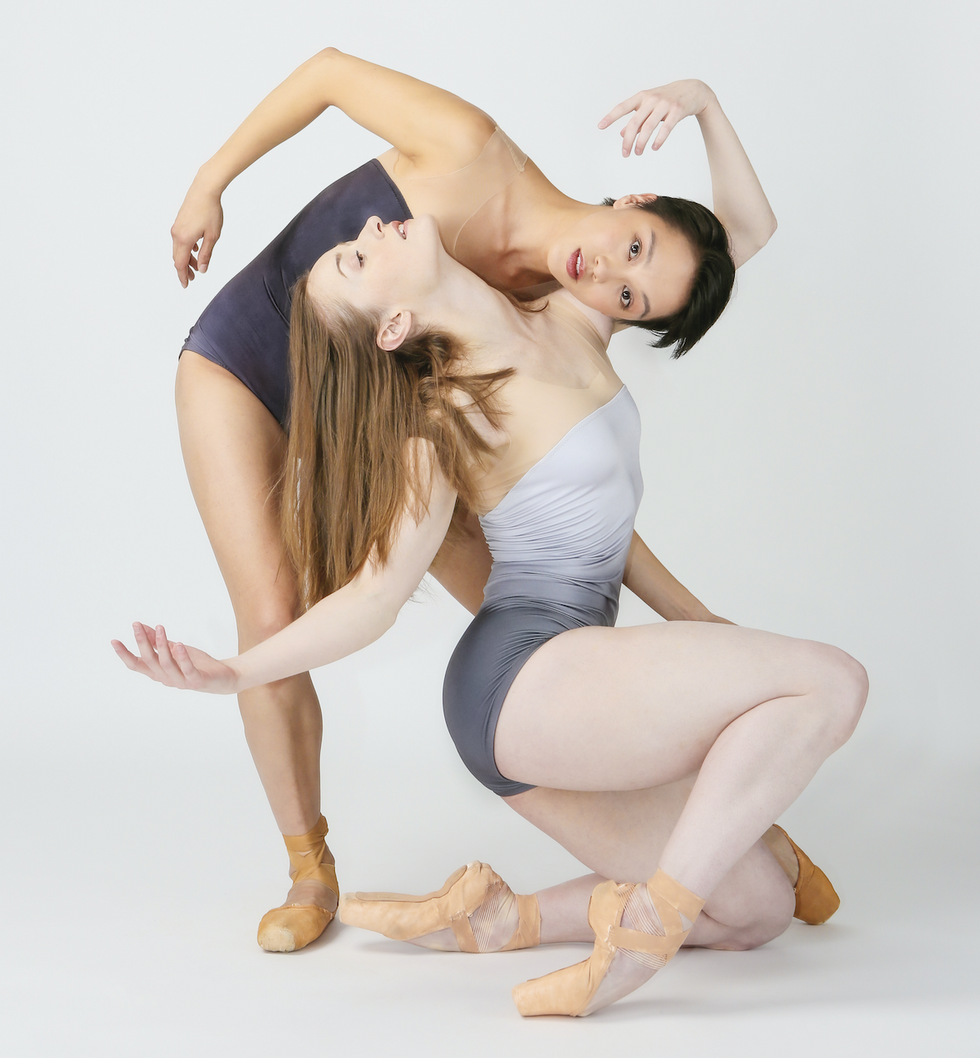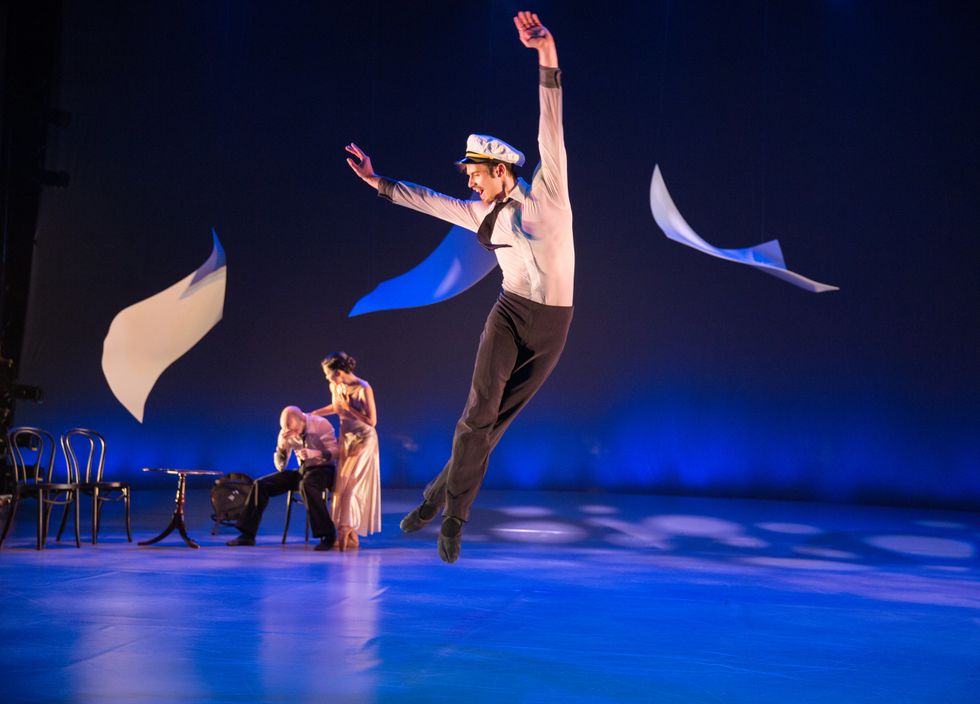BalletX is Taking All the Right Risks
In a sensual, troubled duet to the music of Amy Winehouse, dancers Chloe Perkes and Zachary Kapeluck channel the late singer’s fraught relationship with fame, performance and love. They embody the haunting gravity of her story—while wearing enormous pairs of bunny ears.
On paper, Trey McInytre’s Big Ones sounds like it shouldn’t work. But risky choices are par for the course at BalletX, and this risk pays off. Founded as a summertime pickup troupe in 2005 by Christine Cox and Matthew Neenan when they were dancers at Pennsylvania Ballet, BalletX is dedicated to performing new work—and lots of it. Its repertory boasts a whopping 76 world premieres in 14 years.
Concepts that wouldn’t work at other companies work at BalletX, says Neenan, because the dancers are so acclimated to taking risks, and the artistic staff is so enthusiastic about supporting them. Although he stepped down as co-director in 2014 to focus on his choreography, the company has been a launchpad for Neenan, who attributes much of his success—including recent commissions at New York City Ballet and Pacific Northwest Ballet—to his work on BalletX.
The company has served other choreographers similarly: Annabelle Lopez Ochoa, perhaps the most prolific woman working in ballet today, received her first American commission at BalletX in 2008. She’s now made five pieces for the troupe, including her recent full-length The Little Prince.
“With young female choreographers, if your work is just okay, companies tend to wait a long time to invite you again,” says Lopez Ochoa. “But BalletX has given me a platform to make pieces that are not perfect.”

Bill Herbert, Courtesy BalletX
Cox commissions choreographers of a range of experience levels, and delicately balances giving them the freedom to experiment while also setting extremely high expectations. The company’s prestigious Choreographic Fellowship, for instance, invites emerging artists to make new work under the guidance of an esteemed mentor. Applicants not chosen for the fellowship are welcome to participate in a peer-to-peer program, where they can observe choreographers like Lopez Ochoa in rehearsal and have intimate lunch conversations with Cox.
The company has begun fostering choreographers internally, too: Dancer Caili Quan will be making her first main-stage work on her colleagues next summer.
In its 14 year history, BalletX has only performed six works that were not originally made on its own dancers. “Everything is very genuine, the feelings that we’re feeling, because they were developed over six weeks,” says Perkes, who’s been with the company since 2010. “Not because we saw someone else do it.”
Many of the dancers were drawn to BalletX for the opportunity to experience the creative process more often. Though most have a strong classical foundation, they are anything but cookie-cutter. They don’t just look different from one another, they move differently from one another—and this difference is cultivated rather than discouraged.
Yet when dancing as an ensemble, they are a powerful, unified force. That’s partially because most of them have been performing together long enough to predict how the person next to them is going to interpret a phrase, says Quan, who joined in 2013. With 40-week contracts and health insurance, the company has an incredibly low turnover rate.

BalletX’s growth hasn’t been seamless. At the beginning, there was the misunderstanding that the company was somehow affiliated with PAB. “Even when we went to Vail in 2012, everyone there was like, ‘Oh, are you here with Pennsylvania Ballet?’ ” says Neenan. (Cox retired from PAB in 2006; Neenan in 2007, serving as PAB’s choreographer in residence ever since.)
When Neenan transitioned from BalletX’s co-director to choreographer, Cox had to convince her board that she was capable of running the company alone. Still today there is confusion about who is leading the troupe: Because Neenan has made so much work there—and his Sunset, o639 Hours, about the first airmail flight across the Pacific Ocean, has become one of the company’s signature pieces—some are mistaken that BalletX is “his company.” (The fact that there are still relatively few women leading ballet companies likely has something to do with it too.)
Cox used to choreograph on the dancers as well, but stopped because she didn’t want her personal insecurities to interfere with her ability to advocate for the choreographers she was commissioning. “I wanted to be excited about everything that was happening onstage, and I was so critical of my own work that I couldn’t do that,” she says. “It made me too vulnerable, making work, to be able to build a company at the same time.”
Her dedication and lack of ego has trickled throughout the company, says Perkes. Cox’s office door is always open, and her influence is apparent in how close-knit the company is, as well as how they are cast: Though some dancers (notably Perkes) have seniority and star power, roles are generally distributed evenly.
A native Philadelphian—a fact she often proudly announces at shows—Cox still hasn’t lost the sense of hustle that’s transformed BalletX from a pickup troupe to a major institution. There’s still something endearingly old-school and personal about her approach, whether it’s keeping postcards in her back pocket to hand out to potential audience members, or calling every single person who makes a donation—no matter how small—to thank them.

Sunset o639 Hours Alexander Iziliaev, Courtesy BalletX
The past five years have skyrocketed BalletX’s national profile, thanks in part to repeat appearances at Vail Dance Festival, New York City’s Joyce Theater and Jacob’s Pillow Dance Festival. Last year, the company started touring internationally, with stops in Bermuda and Serbia.
And after many years of schlepping from studio to studio across the city, last April BalletX opened a home base, a sprawling 5,000-square-foot warehouse space in South Philadelphia aptly named the Center for World Premiere Choreography.
It’s already transformed the company physically, says Perkes. “It’s like dancing on top of a mountain. When you have 50 feet above you, you can imagine your arm reaching through that.” The space invites community engagement, too, with huge glass windows and a set of stylish bleachers where patrons, community members and students are often welcomed in to observe rehearsal.
Up next: More original work, at an even faster pace, and more performances, at new local venues (their seasons at Philadelphia’s Wilma Theater almost always sell out) and, hopefully, nationally and internationally.
Over and over again, Cox has manifested the company’s success through sheer willpower and her belief in the value of new work. “She grew the whole thing. I watched it happen,” says Quan. “And just by force. Nothing was beautifully handed to her, and she fought for us.” She’s not done fighting yet.



